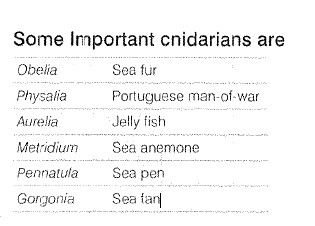lnvertcbrates account for `95%`, of the total animal species.
In invertebntcs, notochord is absent. Non-chordata divided into two sub-kingdom.
1. Sub-kingdom-Protozoa
• Protozoans arc small, microscopic, unicellular organisms with varied forms.
• They may be aquatic (freshwater or marine), terrestrial, free-living or parasites, parasitic forms cause diseases in
humans and animals. The mode of nutrition can be holozoic, holophytic or parasitic.
• They show intracellular labour division, i.e. different
organelles arc present to perform different functions.
• Locomotory organelles arc pseudopodia!, flagella or cilia. Exchange of gases takes place through ~he general
body surf ace of the individuals.
• Excretion occurs by contractile vacuole through general body surface. Asexual reproduction occurs by binary
fission (e.g. Leishmania), multiple fission or budding (e.g. Plasmodium). Sexual reproduction occurs by
syngamy or conjugation.
Classificatiion
On the basis of locomotory organs, phylum-Protozoa is
divided into four groups
(i) Zooflagcllata, e.g. Trypanosoma , Leishmania, Giardia.
(ii) Sarcodina (Rhizopoda), e.g. Amoeba, Entamoeba.
(iii) Sporozoa, e.g. Plasmodium.
(iv) Ci.iiata, e.g. Vorticella, Optdina.
2. Sub-kiingdom-Metazoa
Sub-kingdon-Jvlctazoa includes following phyla
Phylum-Porifera (Sponges)
• AII sponges arc aquatic, mostly marine, rarely freshwater (e.g. Spongillia ), solitary or colonial.
• They have cellular or tissue level organisation .They are diploblastic.
• Sponges have high generative power.
• Body is porous. The pores arc of two types, i.e. ostia and osculun.
• The central body cavity of a sponge is called spongocoel.
• For protection they possess cells called as cnidoblasts.
• Spongococl is lined by flagellate cells called collar cells.
Skeleton forming cells arc called sclcrocytes.
• Skeleton is made up of either siliceous spicules or
proteinaceous spongin fibres or both.
• Sponges reproduce both asexually (by budding) and
sexually. Sponges have very high regeneration power.
Classification
On the basis of skeleton, phylum-Porifera is divided into
three classes
(i) Calcarea, e.g. Sycon, Leucosolenia.
(ii) HexaKtincllida or Hyalospongiac, e.g. Euplectella, llyrdoncma.
(iii) Dcmospongiac, e.g. Fuspongia, Spongilla
• Some common sponges arc
(i) Euplcctella (venus flower basket)
(ii) Hytdonema (glass rope sponge)
(iii) Euspongla (bath sponge)
(v) Chalina (mermaid's glove)
(v) Hiippospongw (horse sponge)
lnvertcbrates account for `95%`, of the total animal species.
In invertebntcs, notochord is absent. Non-chordata divided into two sub-kingdom.
1. Sub-kingdom-Protozoa
• Protozoans arc small, microscopic, unicellular organisms with varied forms.
• They may be aquatic (freshwater or marine), terrestrial, free-living or parasites, parasitic forms cause diseases in
humans and animals. The mode of nutrition can be holozoic, holophytic or parasitic.
• They show intracellular labour division, i.e. different
organelles arc present to perform different functions.
• Locomotory organelles arc pseudopodia!, flagella or cilia. Exchange of gases takes place through ~he general
body surf ace of the individuals.
• Excretion occurs by contractile vacuole through general body surface. Asexual reproduction occurs by binary
fission (e.g. Leishmania), multiple fission or budding (e.g. Plasmodium). Sexual reproduction occurs by
syngamy or conjugation.
Classificatiion
On the basis of locomotory organs, phylum-Protozoa is
divided into four groups
(i) Zooflagcllata, e.g. Trypanosoma , Leishmania, Giardia.
(ii) Sarcodina (Rhizopoda), e.g. Amoeba, Entamoeba.
(iii) Sporozoa, e.g. Plasmodium.
(iv) Ci.iiata, e.g. Vorticella, Optdina.
2. Sub-kiingdom-Metazoa
Sub-kingdon-Jvlctazoa includes following phyla
Phylum-Porifera (Sponges)
• AII sponges arc aquatic, mostly marine, rarely freshwater (e.g. Spongillia ), solitary or colonial.
• They have cellular or tissue level organisation .They are diploblastic.
• Sponges have high generative power.
• Body is porous. The pores arc of two types, i.e. ostia and osculun.
• The central body cavity of a sponge is called spongocoel.
• For protection they possess cells called as cnidoblasts.
• Spongococl is lined by flagellate cells called collar cells.
Skeleton forming cells arc called sclcrocytes.
• Skeleton is made up of either siliceous spicules or
proteinaceous spongin fibres or both.
• Sponges reproduce both asexually (by budding) and
sexually. Sponges have very high regeneration power.
Classification
On the basis of skeleton, phylum-Porifera is divided into
three classes
(i) Calcarea, e.g. Sycon, Leucosolenia.
(ii) HexaKtincllida or Hyalospongiac, e.g. Euplectella, llyrdoncma.
(iii) Dcmospongiac, e.g. Fuspongia, Spongilla
• Some common sponges arc
(i) Euplcctella (venus flower basket)
(ii) Hytdonema (glass rope sponge)
(iii) Euspongla (bath sponge)
(v) Chalina (mermaid's glove)
(v) Hiippospongw (horse sponge)





